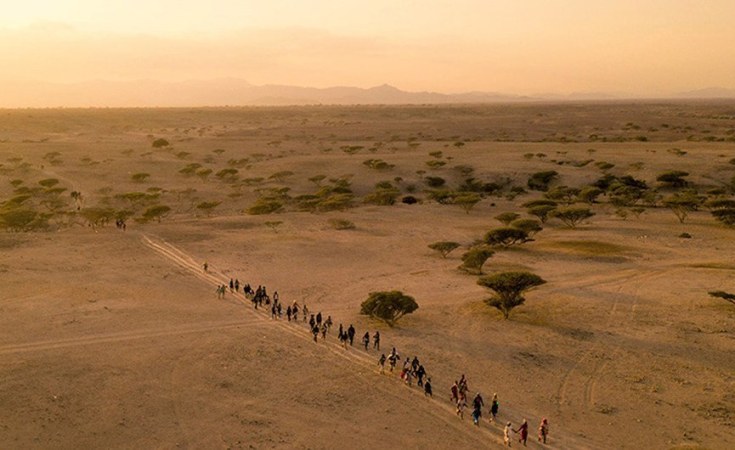The number of forcibly displaced people increased to 108 million in 2022 and is expected to reach 117 million by the end of 2023, according to the United Nations Refugee Agency (UNHCR).
Of these, just over 60 million were internally displaced - people who have been forced to leave their homes but have not crossed their (internationally recognised) borders. Almost 30 million were refugees outside their country of origin. The remainder were asylum seekers, stateless persons, returnees and persons in need of international protection.
UNHCR offers a geographical breakdown. Just over a fifth (22%) of the forcibly displaced people are in Europe, 18% in the Americas, 18% in East and Horn of Africa, 14% in the Middle East and North Africa, 11% in West and Central Africa, 9% in South Africa and 9% in Asia and the Pacific.
A recent report by the agency calls for a more equitable sharing of responsibility for hosting as low- and middle-income countries bear the heaviest burden of hosting people.
The protection of displaced people is also crucial. In January and February 2023 alone, 368 people died on their journey across the sea in Europe.
That is why it is essential to know in detail the facts about displaced people, and the causes of displacement.
It's clear that patterns are emerging of why people leave their homes and places of birth. These range from violence and extreme weather events as a result of climate change, to harassment or persecution. Steps need to be taken as the number of people fleeing continues to rise.
Conflict and violence
Based on data from migration and refugee organisations, conflict and violence have been identified as the primary causes of displacement.
This is the main reason the number of internally displaced people has grown so rapidly. Over the past decade, the number grew by 113%.
The war in Ukraine has caused the fastest displacement and one of the largest since the second world war. At the end of last year, according to UNHCR, an estimated 6.5 million people had been internally displaced, and Europe recorded 7.8 million refugees from Ukraine, mostly women and children.
The outbreak of the war in Syria in 2011 caused more than 12 million Syrians to flee their homes. Almost 7 million have been displaced internally and more than 5 million have sought asylum abroad, mainly in neighbouring countries such as Turkey, Lebanon and Jordan.
The situation has not improved, and since May 2022 asylum applications have increased, returning to the levels of 2015 and 2016.
The number of asylum applications from Afghanistan increased to 3 million in 2022. Most - 80% - are women, girls and boys. Within Afghanistan, UNHCR has recorded over 1 million internally displaced Afghans who have voluntarily returned since August 2021. However, despite these returns, approximately 3.4 million people still remain internally displaced due to conflict.
The EU+ recognition rate for Afghan refugees decreased from 66% in 2021 to 54% in 2022.
The case of Venezuela is also relevant. More than 7 million Venezuelans have been forced to leave their homes since 2015 due to insecurity and economic instability in their country. Colombia (2.48 million) and Peru (1.49 million) are the two main destinations, followed by the United States, Ecuador, Spain and Chile.
Extreme weather, persecution and economic factors
Another major cause of forced displacement is changes in weather patterns and the disasters that occur as a result.
According to the International Displacement Monitoring Centre, in 2022, 8.7 million people were internally displaced as a result of these disasters, 45% more than in 2021. More than half of recent displacements have been due to floods.
For example, the Central American Dry Corridor, which encompasses Nicaragua, Honduras, Guatemala, Costa Rica and El Salvador, is known for its extreme weather conditions. From hurricanes to earthquakes and floods, the region's 11 million inhabitants face repeated natural disasters.
The World Bank estimates that by 2050, more than 140 million people could be forced to migrate due to climate disasters in the regions of Latin America (17 million), sub-Saharan Africa (86 million) and South Asia (40 million) alone.
Another cause of forced migration is persecution or harassment on the basis of political or sexual orientation or gender identity. Consensual same-sex sexual relations are criminalised in 62 countries and capital punishment exists in 11. Identifying the exact number is not easy as records sometimes do not specify the exact type.
In addition, there are still many authoritarian systems in which the opposition is systematically persecuted.
Finally, economic factors also affect displacement. The search for better economic conditions does not fall within the factors that allow for recognition of refugee status under the 1951 Convention and is usually categorised as voluntary migration.
These factors are often associated with political instability, conflict or vulnerability to climatic variations.
Rights in host countries
A number of issues are critical to improving the situation. These include labour integration, the rights of refugees in the host country, the frameworks needed to manage and normalise migration in the long term, the impact of climate change on forced displacement, and misinformation about migration when it is used as a weapon of political polarisation.
The current situation of forced displacement unfortunately continues to worsen as more people flee their places of origin. It is essential to continue to make their situation visible so that everyone in the world has the right to a dignified and prosperous life.
A version of this article was originally published in IE Insights, IE University's knowledge hub.
Borja Santos Porras, Director Ejecutivo - IE School of Global and Public Affairs, IE University


